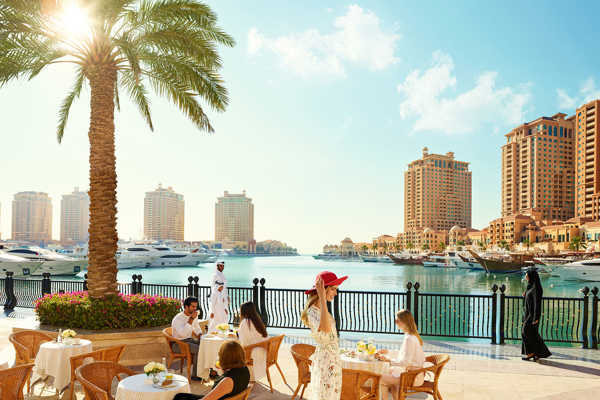Many villages and towns in Qatar have remained mostly untouched for decades while the nation's capital has developed in leaps and bounds. Some were even abandoned within the last century, and the ruins of homes, mosques and forts tell the story of a nation with a rich history.
If you’re planning a trip to Qatar and want to escape the hustle and bustle of Doha, we recommend visiting these charming villages and towns. Some of these destinations have impressive historical landmarks you won’t find elsewhere, so get your camera ready for some impressive shots throughout your visit.
What are the best villages in towns in Qatar to visit?
- 1
Al Khor
Islands and city beaches perfect for relaxation

- Aileler
- Grup
- Fotoğraf
Al Khor was once a famous centre for the pearl industry in Qatar. Its skyline is dominated by 3 watchtowers, some of which have been restored to their original appearance. Al Thakhira Beach, where you can relax under the sun, cooled by the gentle breeze, is popular. Fishing and kayaking are some of the most popular activities. If you prefer privacy, head to Farkeh Beach or Al Khor Island, where Purple Island Beach is the main attraction.
For the best views of unique plant life and bird species, we recommend kayaking through the Al Thakira Mangroves and Jazirat Bin Ghannam, an island that sees migratory birds such as flamingos and herons in winter.
Haritafotoğraf: Vincent van Zeijst (CC BY-SA 3.0) değiştirildi
- 2
Al Wakrah
Qatar’s rapidly growing city

- Tarih
- Fotoğraf
Al Wakrah is exactly what you might imagine when trying to picture a typical Arabian town. Despite its proximity to Doha, it’s an excellent place to escape the shadows of the capital’s looming skyscrapers. By the pier, you’ll find the Al Wakrah Heritage Village, where you can get a taste of medieval life in Qatar.
As you walk around the maze of alleyways and courtyards of Al Wakrah Souq, you’ll sense the tradition of fishing and pearl farming that transformed the small village into a large port town. Be sure to check out the restored 17th-century mosque and Al Wakrah Fort. On the beach, you can view the house of Sheikh Ghanim Bin Abdulrahman Al-Thani, a structure of historical importance.
Haritafotoğraf: Alex Sergeev (CC BY-SA 3.0) değiştirildi
- 3
Mesaieed
Paragliding and dune bashing in the desert

- Macera
- Çiftler
Mesaieed is a small industrial town between Doha and Al Wakrah, but its sand dune adventures make it an increasingly popular day-trip destination in Qatar. Here, you can paraglide or bounce over the dunes in a 4x4 as the sun sets over the desert. If you want to relax after a day of adventure, you can have a candlelit traditional dinner under a starry sky before returning to Doha.
Given Mesaieed’s small size and industrial nature, you won’t find many lodgings in the area. Even so, Qatar’s capital is just 40 minutes away and many tour operators offer day tours that include hotel pickup and drop-off. We recommend booking your 8-hour desert safari at least 48 hours in advance.
Haritafotoğraf: Alex Sergeev (CC BY-SA 3.0) değiştirildi
- 4
Al Zubarah
UNESCO World Heritage site

- Tarih
- Fotoğraf
Al Zubarah, a UNESCO World Heritage site since 2013, is one of Qatar’s most impressive walled cities. While it flourished as a trading centre during the 18th and 19th centuries, it was abandoned in the early 19th century when the pearl trade diminished. Fortunately, sand blown from the desert has preserved the remains of historic buildings such as palaces, courtyard houses, fisherman’s huts and mosques.
While visiting Al Zubarah, check out the nearby fort of Qal’at Murair, where you can admire Islamic architecture at its best and learn about how the desert’s water supplies were protected and managed.
Açık olduğu saatler: Saturday–Thursday from 9 am to 5 pm, Friday from 12.30 pm to 5 pm
Haritafotoğraf: Steven Byles (CC BY-SA 2.0) değiştirildi
- 5
Al Rayyan
Where new meets old in Qatar

- Tarih
- Alışveriş tutkunları
Al Rayyan has a historic centre with intact fortifications and mosques dating back to the 18th and 19th centuries. Qatar’s 2nd most-populous city has an excellent shopping scene, as you can buy designer goods at Wathnan Mall and Mall of Qatar.
International concerts and conferences often take place at the Qatar National Convention Center, which is part of the Qatar Foundation. Within the 1,011-hectare compound, you can find Sidra Hospital and Qatar Science & Technology Park. Visit Mathaf: Arab Museum of Modern Art for exhibits of contemporary art in Al Rayyan. Al Shaqab, also founded by the Qatar Foundation, is an equestrian centre where you can learn about how Arabian horses are trained via guided tours.
Haritafotoğraf: TravelingOtter (CC BY-SA 2.0) değiştirildi
- 6
Al Ruwais
The mysterious Al Jassasiya Carvings

- Tarih
- Fotoğraf
Al Ruwais was once one of Qatar’s most important fishing centres, which is evidenced by the historical fisherman’s huts that take you on a journey back in time. Its namesake 17th-century mosque is believed to be the oldest in the nation. Besides its historical structures and a large port, most travellers visit Al Ruwais for the nearby Al Jassasiya Carvings.
The Al Jassasiya Carvings is around 20 minutes from Al Ruwais. Nearly 900 limestone carvings depict images of cups in rows, ships, rosettes and footprints. While there are dozens of carvings scattered throughout Qatar, the Al Jassasiya Carvings are arguably the most impressive, some dating back as far as 1500 BCE.
Haritafotoğraf: Alex Sergeev (CC BY-SA 3.0) değiştirildi
- 7
Khawr al Udayd
Off-roading to Qatar’s ‘Inland Sea’

- Çiftler
- Aileler
- Tarih
- Fotoğraf
Khawr al Udayd lies just next to the border of Saudi Arabia. Nicknamed the 'Inland Sea', the settlement is one of the few places in the world where the sea encroaches deep into the desert. No roads lead to this Qatari nature reserve, but it’s worth driving over the dunes to relax next to the tranquil expanse of water.
Khawr al Udayd is mostly uninhabited by humans, which has allowed its own ecosystem to flourish. In between dune bashing, swimming and sunbathing, watch out for rare animal species like turtles and dugongs. If you’re lucky, you might catch a glimpse of the endangered osprey nesting on an islet.
Haritafotoğraf: Isabell Schulz (CC BY-SA 2.0) değiştirildi
- 8
Al Shamal (Madinat ash Shamal)
Historic structures and forts in abandoned settlements

- Çiftler
- Tarih
Al Shamal’s tourist appeal is on the rise thanks to its abundance of historic villages, natural areas and archaeological sites. While it has a small population of about 5,000, Al Shamal is known as Madinat ash Shamal or Qatar’s 'City of the North'. Surrounded by the Arabian Gulf, Al Shamal has plenty of sandy coastline stretches, but its abandoned settlements and forts are its main draw.
Qalaat al Thaqab is one of the most fascinating deserted villages in Al Shamal, where you can explore the ruins of Islamic-style homes, cemeteries and walled fortifications. Nearby, the iconic Al Zubarah Archaeological Site has been a UNESCO World Heritage site since 2013.
Haritafotoğraf: Alex Sergeev (CC BY-SA 3.0) değiştirildi
- 9
Umm Salal Mohammed
Qatar’s best nature reserves

- Aileler
- Tarih
- Fotoğraf
Located just 10 km north of Doha, Umm Salal Mohammed is a fortified town full of historic structures and 3 protected environmental areas. In total, the Sunai, Wadi Sultan and Umm Al Amad reserves span nearly 10 sq km with rich biodiversity and sprawling desert scrub landscapes. Nature lovers will appreciate the fact that the world’s largest humanmade forest is set to be established in the area.
If you’re more interested in history than nature, don’t miss landmarks such as the 19th-century Barzan watchtowers or the Umm Salal Fortress. At Umm Salal Ali, you’ll find prehistoric burial grounds that are believed to be over 5,000 years old.
Harita - 10
Al Jumail
Ruins of traditional houses, mosques and forts

- Tarih
- Fotoğraf
Al Jumail is an abandoned village between Al Arish and Al Ruwais in Qatar’s Al Shamal municipality. Before Qatar’s economic boom, the country was largely dependent on the pearl farming and fishing trades. When such trades became obsolete, coastal towns such as Al Jamail were abandoned, leaving a treasure trove of historical structures for tourists to visit.
Mostly, only the walls and doorway tracts of the town’s houses remain, but the grounds are peppered with shards of pottery, beads and homeware. Besides the forts, the most impressive structure in Al Jumail is its still-standing Mosque minaret. When you’re exhausted from exploring the town’s ruins, walk over to the white sandy beach to enjoy a bit of private relaxation.
Haritafotoğraf: Alex Sergeev (CC BY-SA 3.0) değiştirildi
- 11
Al Rakayat Fort
A 19th-century desert fort

- Ekonomik
- Tarih
- Fotoğraf
Set beside a camel ranch in the north-west Qatar desert lies the stony structure of Al Rekayat Fort. Around 9 km from Al Ruwais, in the Madinat Ash Shamal municipality, the fort was constructed in the 19th century to protect local water sources. One of many desert forts, Al Rekayat is one of the few that were restored during the 1980s. The fort is built from blocks of coral and clay with spacious central courtyard surrounded by 3 rectangular towers and a single cylindrical one, a common design for desert forts.
Surrounded by the remains of an abandoned village, Al Rekayat Fort is freely accessible to the public. You will need a 4WD to get to the area, though.
Konum: Madinat ash Shamal, Qatar
Açık olduğu saatler: Saturday, Monday, and Wednesday from 9 am to 5 pm, Friday from 12.30 to 5 pm (Closed Sunday, Tuesday, and Thursday)
Harita - 12
Al Thaqab Fort
The haunting remains of a ghost town

- Ekonomik
- Tarih
- Fotoğraf
Al Thaqab Fort is one of the many 19th-century fortifications in the Qatari deserts. The remains of the town it’s named after are scattered across the neighbouring landscape. The fort’s name translates as 'the water that collects in the bottom of the valley after the rain' and it's believed to have been built to protect a deep well located to the west of the fort.
The fort has rooms once dedicated to processing and storing dates that grew in the area within its limestone and coral walls. The fort was renovated in the 1980s, then again in 2003. Al Thaqab Fort is approximately 3 km from Al Rakayak fort, with both sites being easily visited in a single trip.
Konum: Qalaat al Thaqab, Madinat ash Shamal, Qatar
Haritafotoğraf: Alex Sergeev (CC BY-SA 3.0) değiştirildi
- 13
Ruwayda archaeological site
Home to one of Qatar's largest forts

- Ekonomik
- Tarih
Despite its ancient heritage, Ruwayda archaeological site was only excavated between 2009 and 2014. First identified in the 1970s, little was known about the settlement, which was once dominated by a large fortress. The site now comprises one of the largest archaeological sites in northern Qatar, stretching along more than 2.5 km of coastline.
A visit to Ruwayda archaeological site will reveal not only the large ruined fortress but also a palatial residence, a mosque, warehouses and wells along with a walled tomb and a ship repair shop. Having been abandoned in the 18th century, artefacts found on site indicate it was a trade hub with to the east, with ceramics and porcelain from China, Japan and Europe unearthed.
Konum: Ruwayda, Madinat ash Shamal, Qatar
Açık olduğu saatler: Saturday–Thursday from 9 am to 5 pm, Friday from 12.30 pm to 5 pm
Harita



















